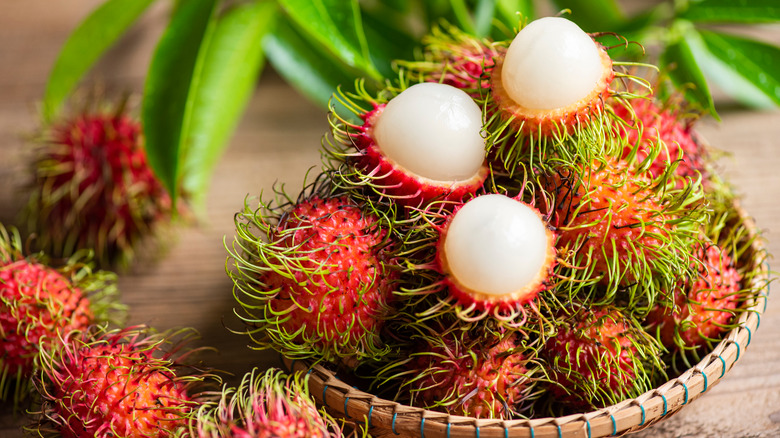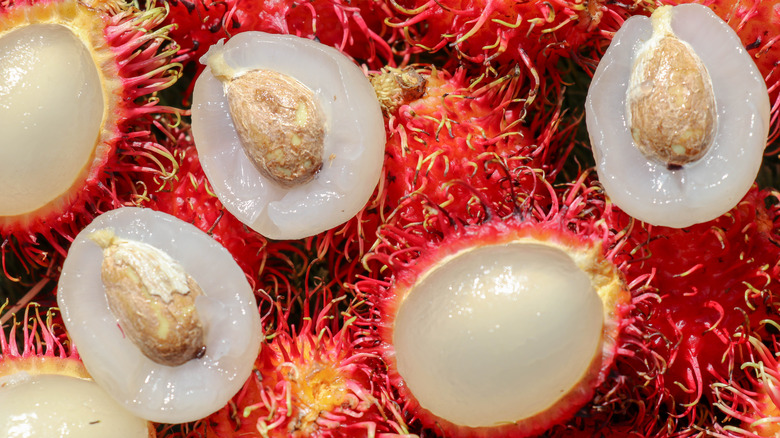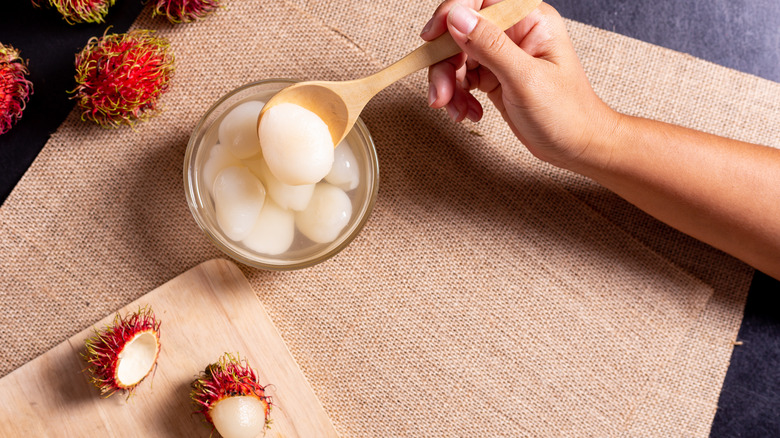How To Eat Rambutan And What Flavors To Expect
Rambutan gets its name from the Malaysian word "rambut," which means "hair." True to its name, this small fruit is encased in a thick red skin covered with soft, hair-like spikes known as spinterns. These supple spinterns, which give the illusion of the fruit being covered in hair, make rambutan a perplexing fruit to navigate. Can the spikes hurt you? Is the flavor worth it? How do you remove the skin to eat a rambutan, anyway? These are all perfectly valid questions!
Native to Indonesia and Malaysia, rambutan is a small, oval fruit with a diameter of three to five centimeters. It belongs to the same soapberry family as lychee and longan. Much like its cousins, rambutan has white, translucent flesh that bursts with a blend of sweet and tart juice. However, to get to this delectable part, you must first remove the inedible rind.
While the spikes may make rambutan appear tough to open, it's actually quite simple: Just make a small cut in the rind and give it a gentle squeeze, allowing the jelly-like flesh inside to slide out. Once it's free from the rind, there are two ways to remove the single seed hidden in the flesh. You can either slice the flesh to extract the seed, or simply pop it into your mouth as is and spit out the seed afterward.
What does a rambutan taste like?
Once you've navigated through its hairy skin and removed the seed wedged inside, you're in for a delicious and juicy experience with this rare farmers market fruit. Rambutan has aqueous flesh, giving it a crisp, clean, and creamy flavor that is both sweet and floral as well as sour and slightly tart. The fruit's taste is reminiscent of a strawberry's sweetness combined with the mild acidity of a grape. While its flavor is often compared to that of a ripe pear or lychee, rambutan is noticeably sweeter than the latter and less floral. Additionally, rambutan has a tartness that is uncommon in lychee.
Given that there are more than 200 varieties of rambutan worldwide, the exact flavor profile will vary depending on the variety. Some types are sweeter than others, some have more pronounced acidity, and the texture of the flesh can range from juicy and aqueous to drier and thicker. The fruit's flavor also depends on its freshness: Fresh rambutans are sweeter, while overripe or spoiled ones take on a funky, fermented flavor.
What can you eat rambutan with?
The sweet, sour, and tart flavors of rambutan are best enjoyed when the fruit is fresh and raw — provided you discard the spiky rind and the seed. The seed of the rambutan can be roasted to neutralize its toxins and is actually consumed in some countries, including the Philippines. However, according to Healthline, the raw seed is considered poisonous due to its narcotic and analgesic properties, which can be lethal in extreme cases. The flesh, on the other hand, is perfectly safe to consume, whether raw or cooked.
In addition to enjoying rambutan raw, its sweet flavor makes it an excellent topping for ice cream sundaes, as well as a component in fruit salads, savory curries, soups, and rich marinades. The fruit can be blended into smoothies, simmered to make thick jams, preserves, and jellies, muddled for cocktails, or cooked down into a floral syrup.
If you're unsure how to enjoy rambutan beyond eating it raw, consider pairing it with tropical fruits like pineapple, kiwi, coconut, and mango. The fruit also pairs wonderfully with poultry, beef, and fish, as well as with aromatics like lemongrass, ginger, turmeric, and mint. Sweeteners such as honey can also complement its flavor. Regardless of whether you choose a sweet or savory preparation, keep in mind that rambutans can only be stored on the countertop for a few days, so it's best to consume them fresh.



